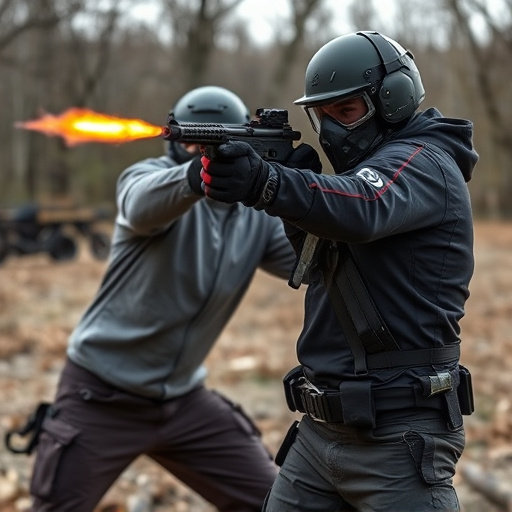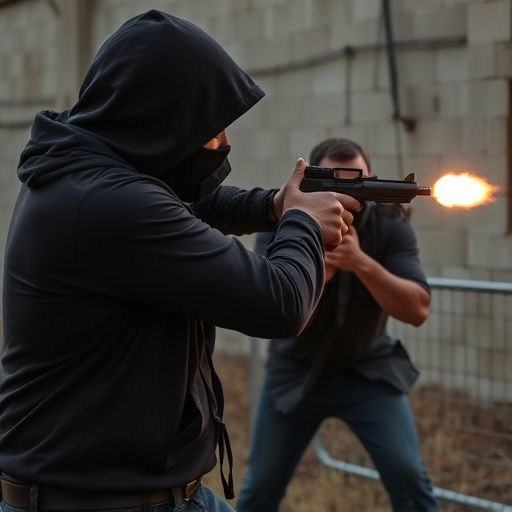Police grade stun gun options vary in size, feature advanced safety mechanisms like laser sights and adjustable shock intensities, and include modern add-ons like UV flashlights and GPS tracking. Tasers, using electrical pulses to temporarily incapacitate, differ from traditional stun guns in their delivery method and potential impact area. Stun guns are often seen as safer for bystanders due to their localized electrical field, while legal acceptability varies based on safety features and application guidelines designed for law enforcement use.
Tasers and stun guns are both non-lethal weapons designed for self-defense, but they differ significantly in design, functionality, and effectiveness. This article explores these differences, focusing on understanding Tasers’ unique capabilities, comparing various police-grade stun gun options, and delving into key distinctions regarding safety and legal considerations. By examining these aspects, users can make informed choices based on their needs.
- Understanding Tasers: Design and Functionality
- Stun Guns: Features and Varieties in Police Grade Options
- Key Differences: Effectiveness, Safety, and Legal Considerations
Understanding Tasers: Design and Functionality

Tasers, officially known as Electronic Control Devices (ECDs), are designed to temporarily incapacitate individuals through the use of electrical current. These tools have become a common sight in law enforcement arsenals and are often used as an alternative to physical force or firearms. Tasers typically consist of two pronged probes connected by thin wires to a gun-like device that fires the probes into the target, delivering a powerful electric pulse. This shock disrupts muscle control, causing the person to fall to the ground and remain temporarily incapacitated.
When considering Police Grade Stun Gun options, understanding Tasers’ design and functionality is crucial. Unlike stun guns that use chemical reactions or high-voltage electrical currents to cause pain and disorientation, Tasers rely on precise electrical pulses delivered through specific points of contact. This technology offers a non-lethal way to subdue individuals while minimizing the risk of permanent injury. The effectiveness of Tasers lies in their ability to neutralize threats quickly, making them valuable tools for police officers in high-risk situations.
Stun Guns: Features and Varieties in Police Grade Options

Stun guns, also known as electroshock weapons, are designed to incapacitate targets by delivering a powerful electric shock. In terms of Police Grade Stun Gun Options, there is a wide array of models and features to suit various needs and budgets. These devices typically use high-voltage, low-current electrical pulses to disrupt the target’s neuromuscular system, causing temporary paralysis and disorientation. Advanced police-grade stun guns often incorporate additional safety features like laser sights for precise targeting and stun patterns that allow officers to adjust the intensity of the shock based on the situation.
The varieties in police-grade options range from compact, easily concealable models suitable for close quarters combat, to more robust devices designed for tactical operations. Some advanced models feature adjustable voltage settings, allowing officers to adapt to different physical builds and resistances. Additionally, modern stun guns may include features like UV flashlights, alarm systems, and even GPS tracking capabilities. These enhancements not only improve effectiveness but also serve as deterrent tools, providing law enforcement with versatile options for public safety and crowd control scenarios.
Key Differences: Effectiveness, Safety, and Legal Considerations

When comparing a Taser to a stun gun, understanding their key differences is crucial. In terms of effectiveness, both devices aim to incapacitate targets through electrical shocks, but they achieve this in distinct ways. A Taser fires two probes connected to wires and delivers an electric current, affecting the nervous system and causing muscle spasms. Conversely, a stun gun generates a high-voltage, low-current pulse that disrupts the target’s nerve impulses, leading to temporary paralysis.
Safety is another critical consideration. Stun guns are generally considered safer for bystanders because their electrical field is localized to the point of contact. In contrast, Tasers have a more widespread effect, potentially impacting anyone nearby. Legal considerations also vary; some areas restrict or prohibit the use of Tasers due to concerns over misuse and unintended consequences. Police-grade stun guns may enjoy broader legality since they are designed with safety features and specific application guidelines in mind, offering users greater flexibility when facing potential threats.
Tasers and stun guns both serve as non-lethal force tools, but they differ significantly in design, effectiveness, and legal status. While Tasers use electrical pulses to disrupt muscle control, stun guns emit a powerful electrical discharge to temporarily incapacitate a target. When choosing between the two, considering factors like effectiveness, safety, and legal restrictions is crucial, especially when selecting from diverse police grade stun gun options available in the market today. Understanding these differences ensures that users make informed decisions based on their specific needs and compliance with local regulations.
